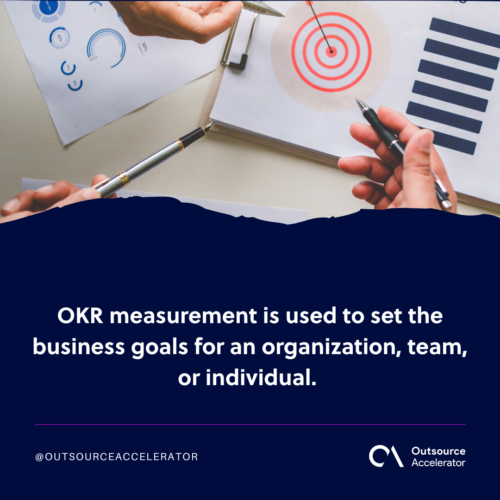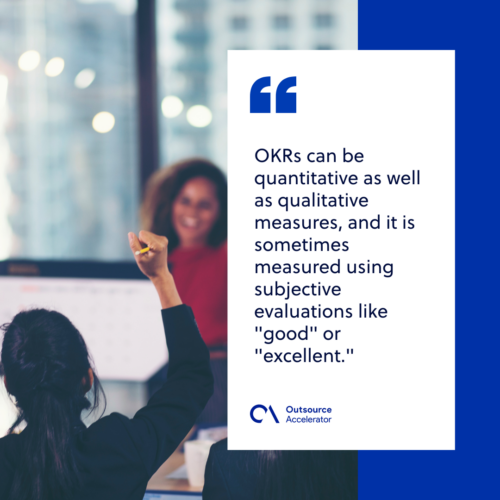OKR measurement: A quick guide

Objectives and Key Results or OKRs aren’t just for big companies.
It is most commonly used by all types of companies, including small and medium enterprises (SMEs)[1] to measure organizational goals and track their progress.
While metrics help understand if goals are being met, OKR isn’t just a measurement but is also considered a tool. It helps companies set specific goals for the year that are measurable and actionable.
With the right planning, OKR measurement can help the team accelerate a project completion rate.
In this article, we’ll discuss what OKR measurement is, its importance, and some of the best practices for businesses.
What is OKR measurement?
OKR stands for Objectives and Key Results. It is a method of setting goals and measuring progress.
OKR measurement is used to set the business goals for an organization, team, or individual.
The goal-setting process involves identifying objectives and creating key results (KR). These are time-bound and measurable objectives that drive performance and growth.

Objectives
An objective is defined as a specific and measurable desired outcome or result that a company wants to achieve within a specified period or within a specific time frame.
For example, “reduce customer churn rate” is not specific enough, while “reduce customer churn rate by 20% over the next three months” tells exactly what objective to achieve.
Key Results (KRs)
The key results are the tasks that need to be completed in order to achieve the objective. Each KR must be measurable to know how much progress has been made toward achieving the objective.
The KRs should be Specific, Measurable, Achievable, Relevant, and Time-bound or SMART.[2]
Differences between OKRs and KPIs
OKRs and KPIs are both used to measure goals and objectives. However, they have some key differences that make them better suited for different uses.
KPIs are typically quantitative and can be measured using hard numbers, such as decimals or percentages.
On the other hand, OKRs can be quantitative as well as qualitative measures, and it is sometimes measured using subjective evaluations like “good” or “excellent.”
There is a common misconception that OKRs are more effective than KPIs since they can measure more subjective criteria.
However, they don’t always provide enough detail to depict the business’s overall performance clearly.

Two methods of OKR grading
OKR is a measurement framework that significantly helps teams define and track quantifiable goals.
There are two ways you can use OKR measurement grading:
Decimal approach
The decimal approach uses a scale from one to ten (or one to five for less complex tasks).
It works best when multiple people are involved with each task, as it allows them to track their own progress and contribute ideas and feedback on how to improve their workflows.
For example, if an objective is to increase sales by 15% over the course of three months, they can use decimals to grade it.
At the end of each month, they can check if the sales have increased by 15%. If they did, then it got a score of 100%. If they don’t, they get a score lower than 100%.
Confidence levels method
The second method for OKR measurement is the confidence levels method which uses percentages instead of numbers on the scale.
This method works if only one person is involved with each task because it requires a more detailed analysis of results before assigning them a grade.
For instance, a team is halfway through the quarter, and OKR says that it needs to sell 50 customers. While it has only sold ten so far (20%), the team can be confident that it can reach the goal with another 20 sales (or not).
OKR measurement best practices for businesses
To help businesses, below are some of OKR measurement best practices to follow:
Align team OKRs with company objectives
It’s important to ensure that the OKRs for each team align with the company’s overall goals.
This alignment helps set expectations and establish accountability so everyone understands what needs to be accomplished and why it’s important.
The greater clarity around these objectives improves employee engagement, which in turn increases productivity and retention rates.
Essentially, the more empowered employees feel about their work, the more likely they are to stay engaged with their company and its success.
Automate with OKR software
Tracking OKRs doesn’t require a lot of time or effort. However, it can be difficult to keep track of each progress when they’re spread across multiple documents or email chains.
That’s why some companies automate this process using software.
It allows teams to create and track their own OKRs while providing real-time visibility into progress across all teams.
Educate employees in the OKR measurement process
People will be more likely to engage in OKRs if they understand what they are and how they work. Employees should have regular training sessions to explain how OKRs work and why they’re important to the business.
Regular reporting
It is important for a business to measure each goal’s progress regularly.
This could mean running monthly reports showing how close employees are to meeting targets.
Companies can also create weekly dashboards for managers and executives, showing how well teams perform.
Keeping track of the progress of OKRs lets everyone know where they stand at any given point in time and if they are progressing toward their objective.
Whether staff or managers, this gives people an incentive to keep pushing themselves and helps identify areas where they need more support.
Importance of OKR measurement
OKR measurement is one of the most effective tools for measuring and improving performance.
Businesses benefit from these metrics, especially for achieving goals and measuring progress in a company.
A company that sets OKR goals for its employees can better align its teams around its mission, vision, and values. And when team members are aligned, they work together more effectively to achieve the company’s vision.
Article References:
[1] Small and medium enterprises (SMEs). Chen, D., Chen, J. and Ning, M. (2022). Research on Enterprise Performance Management from the Perspective of OKR.
[2] SMART (Specific, Measurable, Achievable, Relevant, and Time-bound). Bjerke, M.B. and Renger, R. (2017). Being smart about writing SMART objectives. Evaluation and Program Planning, [online] 61(1), pp.125–127.







 Independent
Independent




